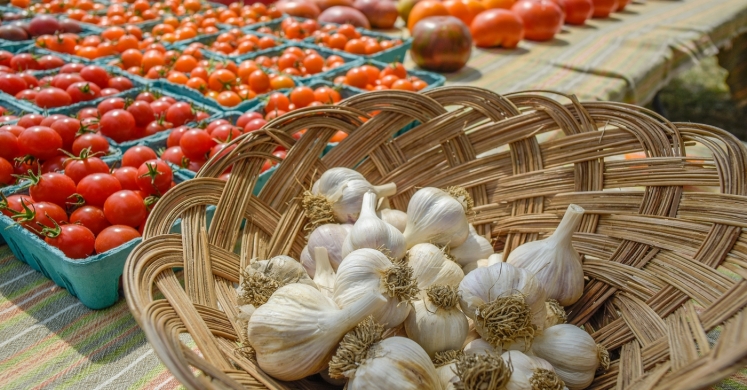Blog

#bioPGH Blog: Tomatoes and Garlic
 A resource of Biophilia: Pittsburgh, #bioPGH is a weekly blog and social media series that aims to encourage both children and adults to reconnect with nature and enjoy what each of our distinctive seasons has to offer. From the best times to plant seasonal flora and enjoy their peak blooms, to astronomical events and creatures to keep an eye and ear out for, Phipps will keep you in the know with what’s going on in our environment!
A resource of Biophilia: Pittsburgh, #bioPGH is a weekly blog and social media series that aims to encourage both children and adults to reconnect with nature and enjoy what each of our distinctive seasons has to offer. From the best times to plant seasonal flora and enjoy their peak blooms, to astronomical events and creatures to keep an eye and ear out for, Phipps will keep you in the know with what’s going on in our environment!
This weekend, Phipps celebrates the mouthwatering union of two popular foods, tomatoes and garlic, at our annual Red, Ripe and Roasted festival on Sun., Aug. 28. Tomatoes and garlic are a common site in local backyard gardens and have been an important — and scrumptious! — part of the human diet for thousands of years. Despite their local abundance, neither tomatoes (Solanum lycopersicum) nor garlic (Allium sativum) are native to western Pennsylvania, so thank the countless generations of artificial selection for that!
The tomato originated in Central and South America, and wild tomato species still grow in the Andes. The Aztec word tomatl gave rise to the Spanish word tomate, from which the English word tomato originated. In Britain and the early American colonies, tomatoes were just ornamental plants because they were thought to be poisonous due to their close resemblance to deadly nightshade. Tomatoes are indeed members of the nightshade family (Solanaceae), which has a number of other toxic plants, like nicotianas (tobacco and petunias), Jimson weed (belladonna) and mandrake. However, Solanaceae includes other edible, delectable plants, like potatoes, peppers and eggplants.
The big, red tomatoes to which we’re accustomed are actually descended from tiny relatives. When the tomato plant was brought to Europe in the 1500s, much of the genetic diversity was left behind in Aztec gardens and the wild. The tomato’s European descendants were slower-growing and frailer than their wild counterparts. On his trip to the Galapagos in 1835, Charles Darwin searched for wild tomatoes, one of the many plant and animal species he collected. Recent work has found remarkable genetic diversity among wild tomato species in South America. This genetic variation could help increase the hardiness of domesticated tomato varieties, allowing cultivation in more extreme climate conditions.
Garlic, another vegetable common to Pennsylvania farms, is also one of the oldest known crops — Egyptian and Indian cultures referred to garlic over 5,000 years ago, and there is historical evidence that it was grown by the Babylonians and Chinese. Garlic is native to central Asia, the only place it still grows wild. Other plants may be referred to as "wild garlic," but these are actually other closely related plants in the garlic genus Allium, not garlic itself (Allium sativum). It is part of the Allinaceae family, home to other delicious yet odiferous vegetables like onion, leek, and shallot.
Yes, it’s tasty, but what exactly causes that pungent, spicy “garlic breath” odor? Garlic contains Alliin, a sulfur-containing compound which breaks down into Allicin after the bulbs are cut, chewed, or crushed. Allicin further breaks down into four volatile organic compounds (VOCs) that are excreted through your breath and skin, and are responsible for notifying others what you’ve just had for lunch. Aside from its culinary contributions, garlic has a long history as a medicinal plant, from increasing strength and productivity in ancient Egypt and Greece to wound treatment for soldiers in World War I.
Connecting to the Outdoors Tip: Visit our Tomato and Garlic Festival this Sunday on the Phipps front lawn from 11 a.m. – 4 p.m. By providing a donation of fresh produce to the Greater Pittsburgh Community Food Bank you will gain free admission to the Conservatory during festival hours. Even though tomatoes are reaching the end of their growing season in Pennsylvania, autumn is the ideal time to plant garlic. If you’re stuck inside on a rainy day, make a paper tomato box.
Continue the Conversation: Share your nature discoveries with our community by posting to Twitter and Instagram with hashtag #bioPGH, and R.S.V.P. to attend our next Biophilia: Pittsburgh meeting.
Resources:
Red, Ripe and Roasted | Phipps Conservatory and Botanical Gardens
Why the tomato was feared | Smithsonian
Solanaceae | Wikipedia
Tomato genetics study | Phys.org
Tomato Production | Penn State Extension
The origins and distribution of garlic | USDA
Why does garlic make your breath smell bad? | American Chemical Society
Garlic history | Allicinfacts
Growing garlic | University of Minnesota
Make a paper tomato box | FlopCloud

